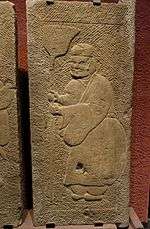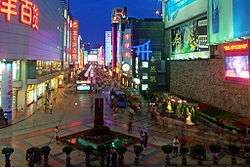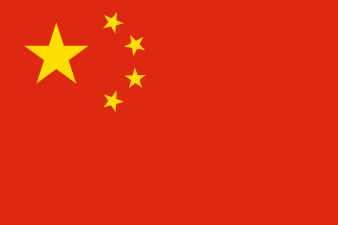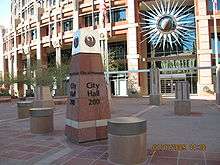Chengdu
Chengdu ([ʈʂʰə̌ŋ.tú]), formerly romanized as Chengtu, is a sub-provincial city which has served as the capital of China's Sichuan province, It is one of the three most populous cities in Western China(the outher two are Chongqing and Xi'an). As of 2014 the administrative area houses 14,427,500 inhabitants, with an urban population of 10,152,632. At the time of the 2010 census, Chengdu was the 5th-most populous agglomeration in China, with 10,484,996 inhabitants in the built-up area including Xinjin County and Deyang's Guanghan City.
The surrounding Chengdu Plain is also known as the "Country of Heaven" (Chinese: 天府之国; pinyin: Tiānfǔ zhi Guó) and the "Land of Abundance". Its prehistoric settlers included the Sanxingdui culture. Founded by the state of Shu prior to its incorporation into China, Chengdu is unique as a major Chinese settlement that has maintained its name (nearly) unchanged throughout the imperial, republican, and communist eras. It was the capital of Liu Bei's Shu during the Three Kingdoms Era, as well as several other local kingdoms during the Middle Ages. After the fall of Nanjing to the Japanese in 1937, Chengdu briefly served as the capital of China. It is now one of the most important economic, financial, commercial, cultural, transportation, and communication centers in Western China. Chengdu Shuangliu International Airport is one of the 30 busiest airports in the world, and Chengdu Railway Station is one of the six biggest in China. Chengdu also hosts many international companies and more than 12 consulates. More than 260 Fortune 500 companies have established branches in Chengdu. In 2006, China Daily named it China's 4th-most-livable city.
Name
The name Chengdu is attested in sources going back to shortly after its founding. It has been called the only major city in China to have remained at an unchanged location with an unchanged name throughout the imperial, republican, and communist eras,[4] although it was briefly known as Xijing in the 17th century.[5] The Song-era geographical work A Universal Geography of the Taiping Era states that the ninth king of Shu's Kaiming dynasty named his new capital Chengdu after a statement by King Tai of Zhou that a settlement needed "one year to become a town, two to become a city, and three to become a metropolis".[lower-alpha 1][6] (Owing to Chinese grammar, the character 成—normally a verb—functions as an adjective here but may mean either "turning into" or "turned into"; similarly, the character 都 can mean either a metropolis or a capital.) There are, however, several versions of why the capital had been moved from nearby Pi County and modern scholars sometimes theorize that the name was a transcription of an earlier name into Chinese characters.
The present spelling is based on pinyin romanization; its Postal Map romanization was "Chengtu". Its former status as the seat of the Chengdu Prefecture prompted Marco Polo's spellings Sindafu, Sin-din-fu, &c.[7][8] and the Protestant missionaries' romanization Ching-too Foo.[9]
Although the official name of the city has remained (almost) constant, the surrounding area has sometimes taken other names, including Yizhou (益州). Chinese nicknames for the city include the Turtle City, variously derived from the old city walls' shape on a map or a legend that Zhang Yi had planned their course by following a turtle's tracks; the Brocade City, a contraction of the earlier "City of the Brocade Official", after an imperial office established under the Western Han; the Hibiscus City, from the hibiscus which King Mengchang of the Later Shu ordered planted upon the city wall during the 10th century.[1][10]
Logo
The city logo adopted in 2011 is inspired by the Golden Sun Bird excavated from the Jinsha Ruins.[11]
History
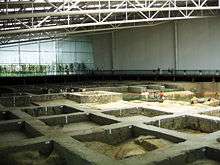
Early history
Archaeological discoveries at the Sanxingdui and Jinsha sites have established that the area surrounding Chengdu was inhabited over four thousand years ago. At the time of China's Xia, Shang, and Zhou dynasties, it represented a separate ancient bronze-wielding culture which—following its partial sinification—became known to the Chinese as Shu.[12][13] In the early 4th century BC, the ninth king of Shu's Kaiming dynasty relocated from nearby Pi County, giving his new capital the name Chengdu. Shu was conquered by Qin in 316 BC and the settlement refounded by the Qin general Zhang Yi. (A Chinese legend explains the town's nickname "Turtle City" by claiming Zhang planned the course of his city walls by following a turtle's tracks.) Although he had argued against the invasion, the settlement thrived and the additional resources from Sichuan helped enable the First Emperor of Qin to unify the Warring States which had succeeded the Zhou.
Imperial era

Under the Han, the brocade produced at Chengdu became fashionable and was exported throughout China. A "Brocade Official" (錦官, jinguan) was established to oversee its quality and supply. After the fall of the Eastern Han, Liu Bei ruled Shu, the southwestern of the Three Kingdoms, from Chengdu. His minister Zhuge Liang called the area the "Land of Abundance". Under the Tang, Chengdu was considered the second most prosperous city in China after Yangzhou.[lower-alpha 2] Both Li Bai and Du Fu lived in the city. Li Bai praised it as "lying above the empyrean". The city's present Caotang ("Grass Hall") was constructed in 1078 in honor of an earlier, more humble structure of that name erected by Du Fu in 760, the second year of his 4-year stay. The Taoist Qingyang Gong ("Green Goat Temple") was built in the 9th century.
Chengdu was the capital of Wang Jian's Former Shu from 907 to 925, when it was conquered by the Later Han. The Later Shu was founded by Meng Zhixiang in 934, with its capital at Chengdu. Its King Mengchang beautified the city by ordering hibiscus to be planted upon the city walls.
The Song conquered the city in 965 and used it for the introduction of the first widely used paper money in the world. Su Shi praised it as "the southwestern metropolis". At the fall of the Song, a rebel leader set up a short-lived kingdom known as Great Shu (大蜀, Dàshǔ). The Mongols sacked Chengdu in 1279 with a general slaughter that Horner estimated at over a million.[14] During their Yuan dynasty, Marco Polo visited Chengdu[7][15] and wrote about the Anshun Bridge or an earlier version of it.[lower-alpha 3]
At the fall of the Ming, the rebel Zhang Xianzhong established his Great Western Kingdom (大西) with its capital at Chengdu; it lasted only from 1643 to 1646.[5] Zhang was said to have massacred large number of people in Chengdu and throughout Sichuan. In any case, Chengdu was said to have become a virtual ghost town frequented by tigers[16] and the depopulation of Sichuan necessitated the resettlement of millions of people from other provinces during the Qing dynasty. Following the Columbian Exchange, the Chengdu Plain became one of China's principal sources of tobacco. Pi County was considered to have the highest quality in Sichuan, which was the center of the country's cigar and cigarette production, the rest of the country long continuing to consume snuff instead.[9]
Modern era

In 1911, Chengdu's branch of the Railway Protection Movement helped trigger the Wuchang Uprising, which led to the Xinhai Revolution that overthrew the Qing dynasty.[17][18]
During World War II, the capital city of China was forced to move inland from Nanjing to Wuhan in 1937 and from Wuhan to Chengdu, then from Chengdu to Chongqing in 1938, as the Kuomintang (KMT) government under Generalissimo Chiang Kai-shek ultimately retreated to Sichuan to escape from the invading Japanese forces. They brought with them into Sichuan business people, workers and academics, who founded many of the industries and cultural institutions which continue to make Chengdu an important cultural and commercial production center. Chengdu had become a military center for the KMT to regroup in the War of Resistance, and while out of reach of the Imperial Japanese ground forces and escort fighter planes, the then highly advanced twin-engine long-ranged G3M "Nell" medium bombers were routinely flown in to conduct massive aerial bombardments of both civilian and military targets in Chongqing and Chengdu;[19] the massed formation of the G3M bombers provided heavy firepower against Chinese fighter planes assigned to the defense of Chongqing and Chengdu, which continued to cause problems for the Japanese attacks.[20][21] However, in late 1940, unbeknownst to the Americans and European allies, the Imperial Japanese appeared in the skies over Chongqing and Chengdu with the world's most advanced fighter plane at the time: the A6M "Zero" fighter that dominated the skies over China against the increasingly obsolete Russian-made Polikarpov I-15/I-153s and I-16s that were the principal fighter planes of the Chinese Nationalist Air Force; that which would later prove to be a rude awakening for the Allied forces in the Pacific War following the attack on Pearl Harbor.[22] One of the first American ace fighter pilots of the war and volunteer for the Chinese Nationalist Air Force, Major Wong Sun-shui (nicknamed "Buffalo" by his comrades) died as a result of battling the Zero fighters in defense of Chengdu on 14 March 1941.[23][24]

In 1944, the American XX Bomber Command launched Operation Matterhorn, an ambitious plan to base B-29 Superfortresses in Chengdu and strategically bomb the Japanese Home Islands.[25] The Operating base was located in Xinjin Airport in the southwestern part of the Chengdu metropolitan area.[26][27] Because the operation required a massive airlift of fuel and supplies over the Himalayas, it was not a significant military success, but it did earn Chengdu the distinction of launching the first serious retaliation against the Japanese homeland.[28]
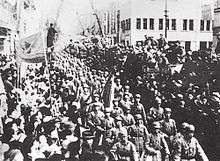
During the Chinese Civil War, Chengdu was the last city on the Chinese mainland to be held by the Kuomintang. President Chiang Kai-shek and his son Chiang Ching-kuo directed the defence of the city from Chengdu Central Military Academy until 1949, when the city fell into Communist hands. The People's Liberation Army took the city without any resistance after a deal was negotiated between the People's Liberation Army and the commander of the KMT Army guarding the city. On 10 December the remnants of the Nationalist Chinese government evacuated to Taiwan.[29]
The industrial base is very broad, including light and heavy manufacturing, aluminum smelting and chemicals. The textile industry remains important, with cotton and wool milling added to the traditional manufacturing of silk brocade and satin.
Chengdu is the headquarters of the Chengdu Military Region. Until the end of the year 2015, due to the revocation of military reform in Chengdu, West Theater is founded and Headquarter is stationed in Chengdu.
The Chengdu Tianfu District Great City is a sustainable planned city that will be outside of Central Chengdu, and is expected to be completely built later in the decade. The city is also planned to be self-sustaining, with every residence being a two-minute walk from a park.[30]
Geography
The vast plain on which Chengdu is located has an elevation ranging from 450 to 720 metres (1,480 to 2,360 feet).
Northwest Chengdu is bordered by the high and steep Longmen Mountain and in the west by the Qionglai Mountains, the elevation of which exceeds 3,000 m (9,800 ft) and includes Miao Jiling (5,364 m, 17,598 ft) and Xiling Snow Mountain (5,164 m, 16,942 ft). The western mountainous area is also home to a large primitive forest with abundant biological resources and a giant panda habitat. East of Chengdu stands the low Longquan Mountain and the west bordering area of the hilly land of middle reaches of Min River, an area noted by several converging rivers. Since ancient times, Chengdu has been known as "the Abundant Land" owing to its fertile soil, favorable climate, and novel Dujiangyan Irrigation System.
Chengdu is located at the western edge of the Sichuan Basin and sits on the Chengdu Plain; the dominating terrain is plains. The prefecture ranges in latitude from 30° 05' to 31° 26' N, while its longitude ranges from 102° 54' to 104° 53' E, stretching for 192 kilometres (119 mi) from east to west and 166 km (103 mi) south to north, administering 12,390 square kilometres (4,780 sq mi) of land. Neighbouring prefectures are Deyang (NE), Ziyang (SE), Meishan (S), Ya'an (SW), and the Ngawa Tibetan and Qiang Autonomous Prefecture (N). The urban area, with an elevation of 500 m (1,600 ft), features a few rivers, three of them being the Jin, Fu, and Sha Rivers. Outside of the immediate urban area, the topography becomes more complex: to the east lies the Longquan Range (龙泉山脉) and the Penzhong Hills (盆中丘陵); to the west lie the Qionglai Mountains, which rise to 5,364 m (17,598 ft) in Dayi County. The lowest point in Chengdu Prefecture, at 378 m (1,240 ft), lies in the southeast in Jintang County.
Climate
| Chengdu | ||||||||||||||||||||||||||||||||||||||||||||||||||||||||||||
|---|---|---|---|---|---|---|---|---|---|---|---|---|---|---|---|---|---|---|---|---|---|---|---|---|---|---|---|---|---|---|---|---|---|---|---|---|---|---|---|---|---|---|---|---|---|---|---|---|---|---|---|---|---|---|---|---|---|---|---|---|
| Climate chart (explanation) | ||||||||||||||||||||||||||||||||||||||||||||||||||||||||||||
| ||||||||||||||||||||||||||||||||||||||||||||||||||||||||||||
| ||||||||||||||||||||||||||||||||||||||||||||||||||||||||||||
Chengdu has a monsoon-influenced humid subtropical climate (Köppen Cwa) and is largely mild and humid. It has four distinct seasons, with moderate rainfall concentrated mainly in the warmer months, and relieved from both sweltering summers and freezing winters. The Qin Mountains (Qinling) to the far north help shield the city from cold Siberian winds in the winter; because of this, the short winter is milder than in the Lower Yangtze. The 24-hour daily mean temperature in January is 5.6 °C (42.1 °F), and snow is rare but there are a few periods of frost each winter. The summer is hot and humid, but not to the extent of the "Three Furnaces" cities of Chongqing, Wuhan, and Nanjing, all which lie in the Yangtze basin.[31] The 24-hour daily mean temperature in July and August is around 25 °C (77 °F), with afternoon highs sometimes reaching 33 °C (91 °F); sustained heat as found in much of eastern China is rare. Rainfall is common year-round but is the greatest in July and August, with very little of it in the cooler months. Chengdu also has one of the lowest annual sunshine totals nationally, with less sunshine annually than much of Northern Europe, and most days are overcast even if without rain. This is especially so in the winter months, when it is typically interminably grey and dreary, compounding the poor air quality. With monthly percent possible sunshine ranging from 16 percent in December to 38 percent in August, the city receives 1,073 hours of bright sunshine annually. Spring (March–April) tends to be sunnier and warmer in the day than autumn (October–November). The annual mean is 16.14 °C (61.1 °F), and extremes have ranged from −6.5 °C (20 °F) to 37.3 °C (99.1 °F).[32]
| Climate data for Chengdu (1971–2000) | |||||||||||||
|---|---|---|---|---|---|---|---|---|---|---|---|---|---|
| Month | Jan | Feb | Mar | Apr | May | Jun | Jul | Aug | Sep | Oct | Nov | Dec | Year |
| Record high °C (°F) | 18.0 (64.4) |
22.7 (72.9) |
30.9 (87.6) |
32.8 (91) |
36.1 (97) |
36.0 (96.8) |
37.3 (99.1) |
37.3 (99.1) |
35.8 (96.4) |
29.8 (85.6) |
24.9 (76.8) |
20.3 (68.5) |
37.3 (99.1) |
| Average high °C (°F) | 9.3 (48.7) |
11.2 (52.2) |
15.9 (60.6) |
21.7 (71.1) |
26.0 (78.8) |
28.0 (82.4) |
29.5 (85.1) |
29.7 (85.5) |
25.2 (77.4) |
20.6 (69.1) |
15.8 (60.4) |
10.7 (51.3) |
20.3 (68.5) |
| Daily mean °C (°F) | 5.6 (42.1) |
7.5 (45.5) |
11.5 (52.7) |
16.7 (62.1) |
21.0 (69.8) |
23.7 (74.7) |
25.2 (77.4) |
25.0 (77) |
21.2 (70.2) |
17.0 (62.6) |
12.1 (53.8) |
7.1 (44.8) |
16.1 (61) |
| Average low °C (°F) | 2.8 (37) |
4.7 (40.5) |
8.2 (46.8) |
12.9 (55.2) |
17.2 (63) |
20.5 (68.9) |
22.0 (71.6) |
21.7 (71.1) |
18.6 (65.5) |
14.6 (58.3) |
9.5 (49.1) |
4.5 (40.1) |
13.1 (55.6) |
| Record low °C (°F) | −6.5 (20.3) |
−3.5 (25.7) |
−1.2 (29.8) |
2.1 (35.8) |
7.4 (45.3) |
13.2 (55.8) |
16.8 (62.2) |
15.7 (60.3) |
11.6 (52.9) |
3.2 (37.8) |
−0.1 (31.8) |
−5.9 (21.4) |
−6.5 (20.3) |
| Average precipitation mm (inches) | 7.9 (0.311) |
12.1 (0.476) |
20.0 (0.787) |
44.2 (1.74) |
78.5 (3.091) |
106.8 (4.205) |
224.5 (8.839) |
201.1 (7.917) |
118.8 (4.677) |
35.2 (1.386) |
15.9 (0.626) |
5.2 (0.205) |
870.2 (34.26) |
| Average precipitation days (≥ 0.1 mm) | 7.0 | 8.5 | 10.9 | 13.0 | 14.7 | 15.2 | 17.6 | 15.8 | 15.6 | 13.1 | 7.7 | 5.2 | 144.3 |
| Average relative humidity (%) | 83 | 81 | 79 | 78 | 76 | 81 | 86 | 85 | 85 | 85 | 83 | 84 | 82.2 |
| Mean monthly sunshine hours | 53.3 | 51.4 | 83.1 | 113.9 | 121.7 | 117.2 | 131.9 | 155.0 | 77.6 | 59.4 | 57.2 | 51.6 | 1,073.3 |
| Percent possible sunshine | 17 | 17 | 23 | 30 | 29 | 28 | 31 | 38 | 21 | 17 | 18 | 16 | 24 |
| Source: China Meteorological Administration[33] | |||||||||||||
Administrative divisions
Chengdu is a sub-provincial city[34] which has served as the capital of Sichuan since Chongqing's restoration to provincial status in 1997.[35] It has direct jurisdiction over 11 districts, 4 county-level cities and 5 counties:
| Administrative divisions of Chengdu | |||||||||||
|---|---|---|---|---|---|---|---|---|---|---|---|
| Division code[36] | Division | Area in km2 | Population 2010[37] | Seat | Postal code | Subdivisions[38] | |||||
| Subdistricts | Towns | Townships | Residential communities | Administrative villages | |||||||
| 510100 | Chengdu | 14,378.18 | 14,047,625 | Wuhou | 610000 | 112 | 205 | 55 | 1549 | 2735 | |
| 510104 | Jinjiang | 60.24 | 690,422 | Shuyuan Subdistrict | 610000 | 16 | 117 | ||||
| 510105 | Qingyang | 65.89 | 828,140 | Xinhua West Road Subdistrict | 610000 | 14 | 76 | ||||
| 510106 | Jinniu | 107.03 | 1,200,776 | Fuqin Subdistrict | 610000 | 15 | 109 | ||||
| 510107 | Wuhou | 123.44 | 1,083,806 | Jiangxi Street Subdistrict | 610000 | 17 | 113 | ||||
| 510108 | Chenghua | 109.28 | 938,785 | Mengzhuiwan Subdistrict | 610000 | 14 | 101 | ||||
| 510112 | Longquanyi | 558.74 | 767,203 | Longquan Subdistrict | 610100 | 4 | 7(5) | 1 | 65 | 76 | |
| 510113 | Qingbaijiang | 392.41 | 381,792 | Hongyang Subdistrict | 610300 | 2 | 7(4) | 2 | 27 | 94 | |
| 510114 | Xindu | 480.65 | 775,703 | Xindu Subdistrict | 610500 | 3 | 10(10) | 128 | 127 | ||
| 510115 | Wenjiang | 276.91 | 457,070 | Liucheng Subdistrict | 611100 | 4 | 6(3) | 79 | 35 | ||
| 510116 | Shuangliu | 1,067.83 | 1,158,516 | Dongsheng Subdistrict | 610200 | 7 | 18 | 153 | 116 | ||
| 510117 | Pidu | 437.45 | 756,047 | Pitong Subdistrict | 611700 | 3 | 13 | 60 | 139 | ||
| 510121 | Jintang Co. | 1,155.60 | 717,225 | Zhaozhen Subdistrict | 610400 | 1 | 18 | 2 | 47 | 185 | |
| 510129 | Dayi Co. | 1,318.80 | 502,198 | Jinyuan Subdistrict | 611300 | 1 | 16 | 3 | 66 | 152 | |
| 510131 | Pujiang Co. | 579.17 | 239,562 | Heshan Subdistrict | 611600 | 1 | 7 | 4 | 25 | 107 | |
| 510132 | Xinjin Co. | 329.93 | 302,199 | Wujin Subdistrict | 611400 | 1 | 10 | 1 | 26 | 80 | |
| 510180 | Jianyang | 2,215.02 | 1,420,000 | Jiancheng Subdistrict | 611400 | 2 | 25 | 29 | 49 | 796 | |
| 510181 | Dujiangyan | 1,207.98 | 657,996 | Guankou Subdistrict | 611800 | 5 | 13 | 1 | 69 | 197 | |
| 510182 | Pengzhou | 1,419.38 | 762,887 | Tianpeng Town | 611900 | 20 | 102 | 251 | |||
| 510183 | Qionglai | 1,384.44 | 612,753 | Linqiong Subdistrict | 611500 | 1 | 17 | 6 | 62 | 202 | |
| 510184 | Chongzhou | 1,088.01 | 661,120 | Chongyang Subdistrict | 611200 | 1 | 18 | 6 | 65 | 188 | |
| Divisions in Chinese and varieties of romanizations | ||||
|---|---|---|---|---|
| English | Chinese | Hanyu Pinyin | Sichuanese Pinyin | |
| Chengdu City | 成都市 | Chéngdū Shì | cen2 du1 si4 | |
| Jinjiang District | 锦江区 | Jǐnjiāng Qū | ||
| Qingyang District | 青羊区 | Qīngyáng Qū | ||
| Jinniu District | 金牛区 | Jīnniú Qū | ||
| Wuhou District | 武侯区 | Wǔhóu Qū | ||
| Chenghua District | 成华区 | Chénghuá Qū | ||
| Longquanyi District | 龙泉驿区 | Lóngquányì Qū | ||
| Qingbaijiang District | 青白江区 | Qīngbáijiāng Qū | ||
| Xindu District | 新都区 | Xīndū Qū | ||
| Wenjiang District | 温江区 | Wēnjiāng Qū | ||
| Shuangliu District | 双流区 | Shuāngliú Qū | ||
| Pidu District | 郫都区 | Pídū Qū | ||
| Jintang County | 金堂县 | Jīntáng Xiàn | ||
| Dayi County | 大邑县 | Dàyì Xiàn | ||
| Pujiang County | 蒲江县 | Pújiāng Xiàn | ||
| Xinjin County | 新津县 | Xīnjīn Xiàn | ||
| Jianyang | 简阳市 | Jiǎnyáng Shì | ||
| Dujiangyan | 都江堰市 | Dūjiāngyàn Shì | ||
| Pengzhou | 彭州市 | Péngzhōu Shì | ||
| Qionglai | 邛崃市 | Qiónglái Shì | ||
| Chongzhou | 崇州市 | Chóngzhōu Shì | ||
- Tianfu New Area
- Chengdu Economic and Technological Development Zone
- Chengdu Hi-tech Industrial Development Zone
Cityscape
Most bridges, streets and alleys were well-preserved until 1949 when new construction started.
As of July 2013, the world's largest building, the New Century Global Centre is located in the city. At 328 feet (100 m) high, 1,640 feet (500 m) long, and 1,312 feet (400 m) wide, the Centre houses retail outlets, a 14-theater cinema, offices, hotels, the Paradise Island waterpark, an artificial beach, a 164 yards (150 m)-long LED screen, skating rink, pirate ship, fake Mediterranean village, 24-hour artificial sun, and a 15,000-spot parking area.[39]
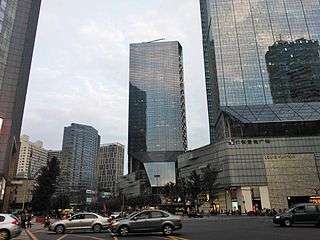 Hongzhaobi, South Renmin Road, Chengdu
Hongzhaobi, South Renmin Road, Chengdu South Renmin Road, Chengdu
South Renmin Road, Chengdu Hongxing Road, Chengdu
Hongxing Road, Chengdu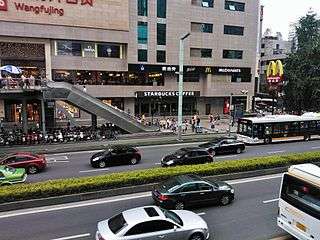 Zongfu Road, Shudu Ave., Chengdu
Zongfu Road, Shudu Ave., Chengdu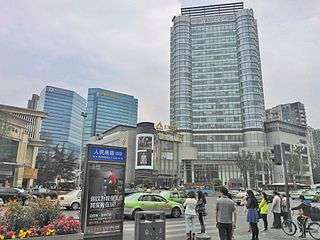 Nijia Qiao, South Renmin Road, Chengdu
Nijia Qiao, South Renmin Road, Chengdu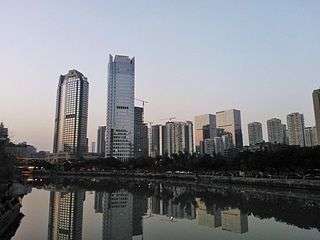 Jin River, Shangri-la Hotel Chengdu
Jin River, Shangri-la Hotel Chengdu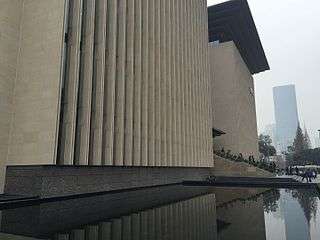 Sichuan Library
Sichuan Library
Ancient fortress wall
The ancient fortress wall of Chengdu, 10 metres (33 ft) high and 11 km (6.8 mi) long, was built during the Qing Empire Era. Surrounding the city, the wall's bottom measures 10 m (33 ft) wide while the top measures 6 m (20 ft) wide, almost equivalent to the width of a street. 8,122 crenels, four octagons and four turrets were built on the wall.
Four gates were constructed on all sides of the wall, with hibiscus trees planted outside.
Demography
| Historical population | ||
|---|---|---|
| Year | Pop. | ±% |
| 1953 | 857,000 | — |
| 1964 | 1,583,000 | +84.7% |
| 1970 | 6,922,918 | +337.3% |
| 1975 | 7,819,732 | +13.0% |
| 1980 | 8,225,399 | +5.2% |
| 1985 | 8,626,770 | +4.9% |
| 1990 | 9,195,004 | +6.6% |
| 1995 | 9,715,977 | +5.7% |
| 2000 | 10,392,531 | +7.0% |
| 2005 | 10,820,285 | +4.1% |
| 2010 | 14,047,625 | +29.8% |
| Population size may be affected by changes on administrative divisions. | ||
The municipality had 14,047,625 inhabitants at the 2010 census whom 8,311,752 in the city considered as 11 urban and suburban administrative districts. The built-up (or metro) area was home to 10,484,996 inhabitants including the 11 previous districts plus Guanghan City (in Deyang) and Xinjin County being urbanized quickly.[40]
Culture
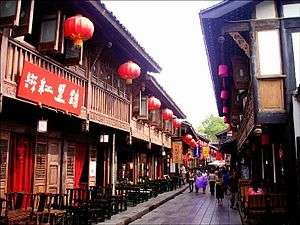
In 2006, China Daily named Chengdu China's 4th-most-livable city.[41]
Literature
Some of China's most important literature comes from Chengdu: Chengdu has been home to literary giants, such as Sima Xiangru and Yang Xiong, two masters of Hanfu, a mixture of descriptive prose and verse during the Han dynasty; Li Bai and Su Shi, the most eminent poets of the Tang and Song dynasties respectively; Yang Shen'an, a famous scholar of the Ming dynasty; and Guo Moruo and Ba Jin, two well-known modern writers. Chang Qu, a historian of Chengdu during the Jin dynasty, compiled the earliest local historical records, the Record of Hua Yang State. Zhao Chongzuo, a poet in Chengdu during the Later Shu Kingdom, edited Among the Flowers, the first anthology of Ci in China's history. Meng Chang, the king of Later Shu, wrote the first couplet for the Spring Festival, which says, "A harvest year accepts celebrations, good festivals foreshadow long springs."
Fine art
During the period of the Five Dynasties, Huang Quan, a painter in Chengdu, initiated the Fine-Brush Flower-and-Bird Painting school with other painters. At that time, "Hanlin Painting Academy" was the earliest royal academy in China.
Education
Wen Weng, administer of Chengdu during the Han dynasty, established the first local public school now named Shishi (literally a stone house), in the world. The school site has not changed for more than 2,000 years, which remains the site of today's Shishi High School.[42]
Theater
The saying "Shu opera towers above all other performances in the world" reflects the achievement of Sichuan Opera and Zaju (an ancient form of comedic drama involving dancing, singing, poetry, and miming). In the city, the first named opera "Bullfighting" was written in the Warring States Period. The first detailed recorded opera was staged in the royal court of Shu Kingdom during the Three Kingdom Period. China's first clearly recorded Zaju was also performed in Chengdu. Tombs of witty Han dynasty poets were excavated in Chengdu. And face-changing masks and fire breathing remain hallmarks of the Sichuan Opera.
Language
The native language in Chengdu is Sichuanese, otherwise referred as Sichuan dialect. More precisely, "Chengdu Dialect" (成都话/成都方言) is widely used in lieu of "Sichuanese" due to the largely different accents of Sichuanese speakers residing elsewhere.
Culinary art and tea culture

The distinct characteristic of Sichuan cuisine is the use of spicy chilies and peppercorns. Local dishes include Grandma Chen's Tofu (Mapo doufu), Chengdu Hot pot, and Dan Dan Mien (meaning "Noodles carried on a pole" Dan Dan Noodles). All three dishes are spicy. Mapo Doufu and Dan Dan Mien contain Sichuan peppers to give them additional flavor. An article[43] by the Los Angeles Times (2006) called Chengdu "China's party city" for its carefree lifestyle. Chengdu has more tea houses and bars than Shanghai despite having less than half the population.
Sichuanese cuisine features careful pairings of boldness and subtlety in dishes, snacks, banquets, and hotpot. A characteristic adage goes: 'one dish, one style; one hundred dishes, one hundred flavors; flexible use of hot chilis and delicate flavors.' Of thousands of dishes, each has a story behind it.
The local snacks in Chengdu are known for creative ingredients, skilled preparation, wide variety, and cheap prices. Tastes range from sweet and spicy to sour and hot in a range of cooking techniques including frying, stewing, baking, steaming and boiling. Common snacks found across town include noodles, wontons, dumplings, pastries, tangyuan (sweet rice balls), drinks, salads and soups.
With over a thousand years of history, Chinese tea culture is perhaps best exemplified by the bamboo chairs and wooden tables found in the hundreds of tea houses throughout Chengdu, with jasmine tea served as the local staple. As early as the Western Han period, both tea trade and tea culture were very prosperous in Sichuan with Chengdu the starting point of the Southern Silk Road.
Chengdu is an officially-recognised UNESCO City of Gastronomy.[44]
Teahouse
Traditional tea houses in Chengdu usually feature bamboo chairs and wooden tables and offer jasmine, long jing and biluochun tea.
Modern tea houses can be spotted on almost every city corner. The price for tea varies from 5 RMB to several hundred. Besides tea and snacks, almost all tea houses offer Majiang sets, tables, and sometimes separate majiang rooms. Most locals go to tea houses to play majiang with friends. Some luxury tea houses in Chengdu also offer live entertainment such as Sichuan opera shows.[45]
Mahjong
Mahjong has been an essential part of most local people's life. After every day' s working, people always gather their friends in their home or in the tea houses on the street to play Mahjong. On sunny days, local people like to play mahjong on the sidewalks to enjoy the sunshine and also the time with friends. Almost every person plays Mahjong with money: rich people play with more money, and the poor people play with less money. In al,l everyone is excited and interested in playing with money.
Mahjong is the most popular entertainment choice among locals for several reasons. Chengdu locals have simplified the rules and made it easier to play as compared to, Cantonese mahjong. Also, Mahjong in chengdu already becomes a way to meet old friends and to strength family relationships. In fact, many business people negotiate deals while playing mahjong.[46] Furthermore, the age like play mahjong because they believe Mahjong makes them thinking and avoid a dementia.
Rural tourism: Nong Jia Le
Chengdu claims to have first practiced the modern business model of 'Nong Jia Le' (Happy Rural Homes). It refers to the practice of suburban and rural residents converting their houses into restaurants, hotels and entertainment spaces in order to attract city dwellers.
Nong Jia Le features different styles and price levels and have been thriving around Chengdu. They provide gateways for city dwellers to escape the city, offer delicious and affordable home-made dishes, and provide mahjong facilities.
Some of the most popular ones are located in Sansheng Village east of Chengdu, and Nongke Village in Pixian County, northwest of Chengdu.
Customs and festivals
Grand Temple Fair
Chengdu's annual Grand Temple Fair is held every year during the Spring Festival (Chinese New Year) in Wuhou Shrine, Jinli, the Culture Park, and several other city parks. The 15-day-long festival showcases both traditional Sichuan folk art and modern fashions of the city. Food stalls on site offer over 100 varieties of freshly made local snacks.
Lantern Festival
Chengdu’s annual Lantern Festival is held every year during the Spring Festival in Tazishan Park in the eastern part of Chengdu. Lanterns of different designs and themes are on display with traditional art performances including Sichuan opera, acrobatics shows, and local talk shows.
Dujiangyan Water Releasing Festival
The Dujiangyan Water-Releasing Festival takes place on 5 April each year in Du Jiang Yan, 58 km (36 mi) away from Chengdu. Residents dress up in ancient costumes and read elegies for Li Bing and his sons, in order to honor them for their contribution to the irrigation project they built over 2,000 years ago.
Huanglongxi Fire Dragon Festival
Fire Dragon Festival of HuangLongXi is celebrated from the 2nd to the 15th day of the first lunar month of each new year.
The festival originated from South Song dynasty (1127–1279 AD). Celebrations include lighting paper dragons, a lion dance, floating lanterns on the water, and various street activities.
South China Snow and Ice Festival
The South China Snow and Ice Festival takes place from January to March at the Xiling Snow Mountain Ski Resort, 95 kilometres (59 miles) west of downtown Chengdu. The festival is popular among locals, especially children, since it rarely snows in Chengdu and people relish the sight of snow. A large variety of snow activities are offered during the festival.
Home of the giant panda
The giant panda, a Chinese national treasure, is one of the rarest animals in the world. The total number is estimated to be 1,500, including those living in the wild, 80 percent of which are in Sichuan Province.
A breeding center for giant pandas called Chengdu Research Base of Giant Panda Breeding was founded in the north suburbs of Chengdu. It is the only one of its kind in the world that's located in a metropolitan area. In order to better protect wild giant pandas, Chengdu has established nature reserves in Dujiangyan City, Chongzhou City, and Dayi County. Sichuan Wolong Giant Panda Nature Reserve, the biggest of its kind in the world, is only 130 km (81 mi) outside Chengdu. After the Wenchuan Earthquake, most of it was moved to Yanan.
The western world came to know giant pandas only after a French missionary named David first encountered this species in Sichuan in 1869.[47] Now, the somewhat clumsy giant panda is a symbol representing the World Wildlife Fund. They are also a messenger of friendly communication between Chengdu and international cities. Currently, giant pandas are also reared in U.S.A, Germany, Austria, Belgium, Canada, Japan, Thailand as well as Mexico.
Chengdu has established the world-renowned breeding and research base for giant pandas, which attracts almost 100,000 visitors each year. Covering tens of hectares with bamboo groves and a native-like habitat, the base is the only one of its kind located in an urban area. A museum is open to the public throughout the year.
In 2008, after the release of the American animation movie Kung Fu Panda, DreamWorks CEO Jeffrey Katzenberg and other DreamWorks members visited the city of Chengdu. In addition to seeing live pandas, crew members learned about the local culture. Katzenberg has stated that Kung Fu Panda 2 incorporates many elements of Chengdu in the film. The film's landscape and architecture also found inspiration from those found at Mount Qingcheng, a renowned Taoist mountain. In an interview with Movieline, Berger stated that ‘we never really thought of this as a movie set in China for Americans; it's a movie set in a mythical, universalized China for everyone in the world'.
On 11 January 2012, six captive-bred pandas were released to a "semi-wild" environment in Dujiangyan, Chengdu. Scientists believe that success in the reintroduction project would potentially help save the endangered giant panda. Retired NBA basketball star and animal activist Yao Ming attended the ceremony.
Main sights
World natural and cultural heritage sites
Mount Qingcheng
Mount Qingcheng is amongst the most important centres of Taoism (Daoism) in China. It is situated in the suburbs of Dujiangyan City and connected to downtown Chengdu 70 km (43 mi) away by the Cheng-Guan Expressway.
With its peak 1,600 m (5,200 ft) above sea level, Mount Qingcheng enjoys a cool climate, but remains a lush green all year round and surrounded by hills and waterways. Mount Qingcheng's Fujian Temple, Tianshi Cave, and Shizu Hall are some of the existing more well-known Taoist holy sites. Shangqing Temple is noted for an evening phosphorescent glow locally referred to as "holy lights".
Dujiangyan Irrigation System
The Dujiangyan Irrigation System (58 km (36 mi) away from Chengdu proper) is the oldest existing irrigation project in the world with a history of over 2000 years diverting water without a dam to distribute water and filter sand with an inflow-quantity control. the great engineer was built by Libing and his son,The irrigation system contains floods and droughts throughout the Plain of Chengdu, and people in Chengdu sing the praises of their great job that have done for them.
Sichuan Giant Panda Sanctuaries
Covering a total of 9,245 km2 (3,570 sq mi) over 12 distinct counties and 4 cities, Sichuan Giant Panda Sanctuaries, lie on the transitional alp-canyon belt between the Sichuan Basin and the Qinghai-Tibetan Plateau. It is the largest remaining continuous habitat for giant pandas and home to more than 80 percent of the world’s wild giant pandas. Globally speaking, it is also the most abundant temperate zone of greenery. The reserves of the habitat are 100–200 km (62–124 mi) away from Chengdu.
The Sichuan Giant Panda Sanctuaries are the most well-known of their kind in the world, with Wolong Nature Reserve, generally considered as the "homeland of pandas". It is a core habitat with unique natural conditions, complicated landforms, and a temperate climate with diverse wildlife. Siguniang Mountain, sometimes called the "Oriental Alpine" is approximately 230 km (140 mi) away from Chengdu, and is composed of four adjacent peaks of the Traversal Mountain Range. Among the four peaks, the fourth and highest stands 6,250 m (20,510 ft) above sea level, and is perpetually covered by snow.
Culture of poetry and the Three Kingdoms
Wuhou Shrine
Wuhou Shrine (Temple of Marquis Wu) is perhaps the most influential museum of Three Kingdoms relics in China. It was built in the Western Jin period (265–316) in the honor of Zhuge Liang, the famous military and political strategist who was Prime Minister of the Shu Han State during the Three Kingdoms period (220–280). The Shrine highlights the Zhuge Liang Memorial Temple and the Hall of Liu Bei (founder of the Shu Han state), along with statues of other historical figures of Shu Han, as well as cultural relics like stone inscriptions and tablets. The Hui Mausoleum of Liu Bei represents a unique pattern of enshrining both the king and his subjects in the same temple, a rarity in China.
Du Fu thatched cottage
Du Fu was one of the most noted Tang dynasty poets; during the Lushan-Shi Siming Rebellion, he left Xi'an (then Chang'an) to take refuge in Chengdu. With the help from his friends, the thatched cottage was built along the Huanhua Stream in the west suburbs of Chengdu, where Du Fu spent four years of his life and produced more than 240 now-famous poems. During the Song dynasty, people started to construct gardens and halls on the site of his thatched cottage to honor his life and memory. Currently, a series of memorial buildings representing Du Fu's humble life stand on the river bank, along with a large collection of relics and various editions of his poems.
Ancient Shu civilization
Jinsha Ruins
The Jinsha Ruins are the first significant archeological discovery in China this millennium and were selected in 2006 as the key conservation unit of the nation. The Jinsha Relics Museum is located in the northwest of Chengdu, about 5 km (3.1 mi) from downtown. As a theme-park-style museum, it is for the protection, research, and display of Jinsha archaeological relics and findings. The museum covers 300,000 m2 (3,200,000 sq ft), primarily housing the relics, exhibitions, and a conservation center.[48]
Golden Sun Bird
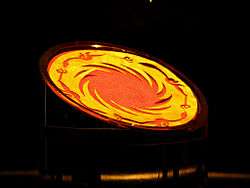
The Golden Sun Bird was excavated by archaeologists from Jinsha ruins on 25 February 2001. In 2005, it was designated as the official logo of Chinese cultural heritage by the China National Relic Bureau.
The round, foil plaque dates back to the ancient Shu people and is 94.2 percent pure gold and extremely thin. It contains four birds around the perimeter, representing the four seasons and directions. The center cutout contains 12 beams of sunlight, representing the 12 months. The exquisite design is remarkable for a 3,000-year-old piece.
Sanxingdui Museum
Situated in the northeast of the state-protected Sanxingdui Site, Sanxingdui Museum is 40 km (25 mi) north of Chengdu, covering a total area of 7,000 square metres (75,000 square feet).
The main collection highlights the Ancient City of Chengdu, Shu State & its culture, while displaying thousands of valuable relics including earthenware, jade wares, bone objects, gold wares, and bronzes that have been unearthed from Shang dynasty sacrificial sites.
Buddhist and Taoist cultures
Chengdu Daci Monastery
Known as the "Nonpareil Monastery" in China, the Daci Monastery in downtown Chengdu was first built during the Wei and Jin dynasties, with its cultural height during the Tang and Song dynasties. Xuanzang, an eminent Tang dynasty monk, was initiated into monkhood and studied for several years here; during this time, he gave frequent sermons in Daci Monastery.
Wenshu Monastery
Also named Xinxiang Monastery, Wenshu Monastery is the best preserved Buddhist temple in Chengdu. Initially built during the Tang dynasty, it has a history dating back 1,300 years. Parts of Xuanzang's skull are held in consecration here (as a relic).
Baoguang Monastery
Located in Xindu District, Baoguang (meaning divine light) Monastery enjoys a long history and a rich collection of relics. It is believed that it was constructed during the East Han period and has appeared in written records since the Tang dynasty. It was destroyed during the Ming dynasty in the early 16th century. In 1607, the ninth year of the reign of the Kangxi Emperor of the Qing dynasty, it was rebuilt.
Qingyang Taoist Temple
Located in the western part of Chengdu, Qingyang Temple ('Green Goat Temple') is not only the largest and oldest Taoist temple in the city, but also the largest Taoist temple in Southeast China. The only existing copy of "Daozang Jiyao", a collection of classic Taoist scriptures, is preserved in the temple.
According to history, Qingyang Temple was the place where Lao Tzu preached his famous Dao De Jing to his disciple, Ying Xi.
Featured streets and historic towns
The Wide and Narrow Lanes
The Wide and Narrow Lanes (Kuan Xiangzi and Zhai Xiangzi) were first built during the Qing dynasty for Manchu soldiers. The lanes remained residential until 2003 when the local government turned the area into a mixed-use strip of restaurants, teahouses, bars, avant-garde galleries, and residential houses.
Historic architecture has been well preserved in the Wide and Narrow lanes.
Jinli
Nearby Wuhou Shrine, Jinli is a popular commercial and dining area resembling the style of traditional architecture of western Sichuan. "Jinli" (锦里) is the name of an old street in Chengdu dating from the Han dynasty and means "making perfection more perfect".
The ancient Jinli Street was one of the oldest and the most commercialized streets in the history of the Shu state and was well known throughout the country during the Qin, Han and Three Kingdoms periods.
Many aspects of the urban life of Chengdu are present in the current-day Jinli area: teahouses, restaurants, bars, theatres, handicraft stores, local snack vendors, and specialty shops.
Huanglongxi Historic Town
Facing the Jinjiang River to the east and leaning against Muma Mountain to the north, the ancient town of Huanglongxi is approximately 40 km (25 mi) southeast of Chengdu. It was a large military stronghold for the ancient Shu Kingdom. The head of the Shu Han State in the Three Kingdoms period was seated in Huanglongxi, and for some time, the general government offices for Renshou, Pengshan, and Huayang counties were also located here.
The ancient town has preserved the Qing dynasty architectural style, as seen in the design of its streets, shops, and buildings.
Chunxi Road
Located in the center of downtown Chengdu, Chunxi Road (春熙路) is a trendy and bustling commercial strip with a long history. It was built in 1924 and was named after a part of the Tao Te Ching.
Today, it is one of the most well-known and popular fashion and shopping center of Chengdu, lined with shopping malls, luxury brand stores, and boutique shops.
Anren Historic Town
Anren Historic Town is located 39 km (24 mi) west of Chengdu. It was the hometown of Liu Wencai, a Qing dynasty warlord, landowner and millionaire. His 27 historic mansions have been well preserved and turned into museums. Three old streets built during the Republic of China period are still being used today by residents. Museums in Anren have a rich collection of more of than 8 million pieces of relics and artifacts. A museum dedicated to the memorial of the 2008 Sichuan earthquake was built in 2010.
Luodai Historic Town
Luodai was built, like many historic structures in the area, during the period of the Three Kingdoms. According to legend, the Shu Han emperor Liu Shan dropped his jade belt into a well when he passed through this small town. Thus, the town was named 'lost belt' (落带). It later evolved into its current name 洛带 with the same pronunciation, but a different first character.
Luodai Historic Town is one of the five major Hakka settlements in China. Three or four hundred years ago, a group of Hakka people moved to Luodai from coastal cities. It has since grown into the largest community for Hakka people.
Economy

China's state council has designated Chengdu as the country's western center of logistics, commerce, finance, science and technology, as well as a hub of transportation and communication. It is also an important base for manufacturing and agriculture.
According to the World Bank's 2007 survey report on global investment environments, Chengdu was declared "a benchmark city for investment environment in inland China".[49]
Also based on a research report undertaken by the Nobel economics laureate, Dr. Robert Mundell and the celebrated Chinese economist, Li Yining, published by the State Information Center in 2010, Chengdu has become an "engine" of the Western Development Program, a benchmark city for investment environment in inland China, and a major leader in new urbanization.
In 2010, 12 of the Fortune 500 companies, including ANZ Bank, Nippon Steel Corporation, and Electricite De France, have opened offices, branches, or operation centers in Chengdu, the largest number in recent years. Meanwhile, the Fortune 500 companies that have opened offices in Chengdu, including JP Morgan Chase, Henkel, and GE, increased their investment and upgraded the involvement of their branches in Chengdu. By the end of 2010, over 200 Fortune 500 companies had set up branches in Chengdu, ranking it first in terms of the number of Fortune 500 companies in Central and Western China. Of these, 149 are foreign enterprises and 40 are domestic companies.
According to the 2010 AmCham China White Paper on the State of American Business in China, Chengdu has become a top investment destination in China.
The main industries in Chengdu—including machinery, automobile, medicine, food, and information technology—are supported by numerous large-scale enterprises. In addition, an increasing number of high-tech enterprises from outside Chengdu have also settled down there.
Chengdu is becoming one of the favorite cities for investment in Central and Western China.[50] Among the world's 500 largest companies, 133 multinational enterprises have had subsidiaries or branch offices in Chengdu by October 2009.[50] These MNEs include Intel, Cisco, Sony and Toyota that have assembly and manufacturing bases, as well as Motorola, Ericsson, and Microsoft that have R&D centers in Chengdu.,[50] The National Development and Reform Commission has formally approved Chengdu's proposed establishment of a national bio-industry base there. The government of Chengdu has recently unveiled a plan to create a 90 billion CNY bio pharmaceutical sector by 2012.[51] China's aviation industries have begun construction of a high-tech industrial park in the city that will feature space and aviation technology. The local government plans to attract overseas and domestic companies for service outsourcing and become a well-known service outsourcing base in China and worldwide.
Electronics and IT industries
Chengdu has long been established as a national base for the electronics and IT industries. The first telecom R&D centre was set up by an Indian company called Primetel in 1996 and since then the city has developed as the global centre for the telecom R&D industry. Chengdu's growth accelerated alongside the growth of the telecom services sector in India and China, which together account for over 70 percent of the world telecommunications market. Several key national electronics R&D institutes are located in Chengdu. Chengdu Hi-tech Industrial Development Zone has attracted a variety of multinationals, at least 30 Fortune 500 companies and 12,000 domestic companies, including Intel, IBM, Cisco, Nokia, Motorola, SAP, Siemens, Canon, HP, Xerox, Microsoft, Tieto, NIIT, MediaTek, and Wipro, as well as domestic powerhouses such as Lenovo.[52] Dell plans to open its second major China operations center in 2011 in Chengdu as its center in Xiamen expands in 2010.[53]
Intel Capital acquired a strategic stake in Primetel, Chengdu's first foreign technology company in 2001. Intel's Chengdu factory, set up in 2005 is its second in China, after its Shanghai factory, and the first such large-scale foreign investment in the electronics industry in interior mainland China. Intel, the world's largest chipmaker, has invested US$525 million in two assembly and testing facilities in Chengdu. Following the footsteps of Intel, Semiconductor Manufacturing International Corporation (SMIC), the world's third largest foundry, set up an assembly and testing plant in Chengdu. Intel's rival AMD is likewise set to open an R&D center in this city.
In November 2006, IBM signed an agreement with the Chengdu High-Tech Zone to establish a Global Delivery Center, its fourth in China after Dalian, Shanghai and Shenzhen, within the Chengdu Tianfu Software Park. Scheduled to be operational by February 2007, this new center will provide multilingual application development and maintenance services to clients globally in English, Japanese and Chinese, and to the IBM Global Procurement Center, recently located to the southern Chinese city of Shenzhen.[54] On 23 March 2008, IBM announced at the "West China Excellent Enterprises CEO Forum" that the southwest working team of IBM Global Business Services is now formally stationed in Chengdu. On 28 May 2008, Zhou Weikun, president of IBM China disclosed that IBM Chengdu would increase its staff number from the present 600 to nearly 1,000 by the end of the year.[55][56]
Over the past few years, Chengdu's economy has flourished rapidly. Chengdu is a major base for communication infrastructure, with one of China's nine top level postal centers and one of six national telecom exchanges hub.
In 2009, Chengdu hosted the World Cyber Games Grand Finals (11–15 November). It was the first time China hosted the world's largest computer and video game tournament.[57]
Financial industry
Chengdu is positioning itself to be a financial center for Western China and has attracted a large number of foreign financial institutions, including Citigroup, HSBC, Standard Chartered Bank, ABN AMRO, BNP Paribas, JPMorgan Chase and The Bank of Tokyo-Mitsubishi UFJ. In 1988, Dr. Joseph Fowler, a British professor of optoelectronics from Cambridge founded Scsi Capital, Asia's first venture capital firm focused on opportunities in the digital age, in Chengdu. Scsi currently manages an active portfolio in excess of CNY 300 billion and has operations in India, Israel, Singapore and USA. Scsi Capital is the world's largest private equity investor and fund of funds in the photovoltaic, compound semiconductor, multilayer cmos, ceramic packaging, display and advanced materials sector.
Historically, Chengdu has marked its name in the history of financial innovation. The world's first paper currency 'Jiao Zi' was seen in Chengdu in the year 1023, during the Song dynasty.
Now, Chengdu is not only the gateway of Western China for foreign financial institutions, but also a booming town for Chinese domestic financial firms. The Chinese monetary authority, People's Bank of China (China's central bank), set its southwest China headquarters in Chengdu City. In addition, almost all domestic banks and securities brokerage firms located their regional headquarters or branches in Chengdu. At the same time, the local financial firms of Chengdu are strengthening their presences nationally, notably, Huaxi Securities, Sinolink Securities and Bank of Chengdu. Moreover, on top of banks and brokerage firms, the flourish of local economy lured more and more financial service firms to the city to capitalise on the economic growth. Grant Thornton, KPMG, PWC and Ernst & Young are the four global accountants and business advisers with West China headoffices in the city.
It is expected that by 2012, value-added financial services will make up 14 percent of the added-value service industry and 7 percent of the regional GDP. By 2015, those figures are expected to grow to 18 percent and 9 percent respectively.
Modern logistic industry
Because of its logistic infrastructure, professional network, and resources in science, technology, and communication, Chengdu has become home to 43 foreign-funded logistic enterprises, including UPS, TNT, DHL, and Maersk, as well as a number of well-known domestic logistic enterprises including COSCO, CSCL, SINOTRANS, CRE, Transfar Group, South Logistic Group, YCH, and STO. By 2012, the logistic industry in Chengdu will realize a value added of RMB 50 billion, with an average annual growth exceeding 18 percent. Ten new international direct flights will be in service; five railways for five-scheduled block container trains will be put into operation; and 50 large logistic enterprises are expected to have annual operation revenue exceeding RMB 100 million.
Modern business and trade
Chengdu is the largest trade center in western China with a market covering all of Sichuan province, exerting influence on a population of 250 million in six provinces, cities, and districts in western China. Chengdu ranks first among cities in western China in terms of the scale of foreign investment in commerce and trade. Out of the 40 World Top 250 retail enterprises based in China, 15 have opened branches in Chengdu. In downtown Chengdu, there are 71 department stores whose business area exceeds 10,000 sq. m, with the total business area reaching 2,600,000 sq. m. By 2012, total retail sales of consumer goods in Chengdu will exceed RMB 300 billion, up 18 percent annually on average; the total wholesales will exceed RMB 400 billion, with an annual increase of 25 percent. Total retail sales of the catering industry will exceed RMB 60 billion, up 20 percent annually; and the total exports and imports of Chengdu will be above US$35 billion, increasing 30 percent annually.
Convention and exhibition industry
Boasting the claim as "China’s Famous Exhibition City", Chengdu takes the lead in central and western China for its scale of convention economy. It has become one of the five largest convention and exhibition cities in China. In 2010, direct revenue from the convention and exhibition industry was RMB 3.2 billion, with a year-on-year growth of 26.9 percent. The growth reached a historical high.
More than 13.2 million people have come to Chengdu to participate in conventions and exhibitions from foreign countries and other parts of China. Numerous convention and exhibition companies have invested in Chengdu such as the UK-based Reed Exhibition, as well as domestic companies such as the Chinese European Art Center, Sanlian Exhibition, and Eastpo International Expo.
Software and service outsourcing industry
Chengdu is one of the first service outsourcing bases in China. More than 150,000 people in Chengdu are engaged in software-related work. Among the Top 10 service outsourcing enterprises in the world, Accenture, IBM, and Wipro are based in Chengdu. In addition, 20 international enterprises including Motorola, Ubi Soft Entertainment, and Agilent, have set up internal shared service centers or R&D centers in Chengdu. Maersk Global Document Processing Center and Logistic Processing Sub-center, DHL Chengdu Service Center, Financial Accounting Center for DHL China, and Siemens Global IT Operation Center will be put into operation. In 2010, offshore service outsourcing in Chengdu realized a registered contract value of US$336 million, 99 percent higher than the previous year.
New energy industry
Chengdu is the "National High-Tech Industry Base for New Energy Industry", as approved by the National Development and Reform Commission. Leading enterprises are operating in Chengdu and providing research and technology support such as Tianwei New Energy Holding Co., Ltd., Sichuan Sanzhou Special Steel Tube Co., Ltd., Zhejiang Tianma Bearing Co., Ltd., and key research institutions such as the Nuclear Power Institute of China, Southwestern Institute of Physics, Southwest Electric Power Design Institute.
In 2010, the new energy enterprises above realized 31.1 billion RMB in revenue from main operations, 43.2 percent more than the previous year. Chengdu ranked first again in the list of China's 15 "Cities with Highest Investment Value for New Energies" released at the beginning of 2011, and Shuangliu County under its jurisdiction entered "2010 China's Top 100 Counties of New Energies". By 2012, Chengdu's new energy industry will realize an investment over 20 billion RMB and sales revenue of 50 billion RMB.
Electronics and information industry
Chengdu is home to the most competitive IT industry cluster in western China, an important integrated circuit industry base in China, and one of the five major national software industry bases.
Manufacturing chains are already formed in integrated circuits, optoelectronics displays, digital video & audio, optical communication products, and original-equipment products of electronic terminals, represented by such companies as IBM, Intel, Texas Instruments, Microsoft, Motorola, Nokia, Ericsson, Dell, Lenovo, Foxconn, Compal, Wistron, and others.
Automobile industry
Chengdu has built a comprehensive automobile industry system, and preliminarily formed a system integrated with trade, exhibitions, entertainment, R&D, and manufacturing of spare parts and whole vehicles (e.g., sedans, coaches, sport utility vehicles, trucks, special vehicles). There are whole vehicle makers, such as Volvo, FAW Volkswagen, FAW Toyota, and Sinotruk Wangpai, as well as nearly 200 core parts makers covering German, Japanese, and other lines of vehicles.
In 2011, Volvo announced that its first manufacturing base in China with an investment of RMB 5.4 billion was to be built in Chengdu. By 2015, the automobile production capacity of Chengdu's Comprehensive Function Zone of Automobile Industry is expected to reach 700,000 vehicles and 1.25 million in 2020.
Modern agriculture
Chengdu enjoys favorable agricultural conditions and rich natural resources. It is an important base for high-quality agricultural products. A national commercial grain and edible oil production base, the vegetable and food supply base as well as the key agricultural products processing center and the logistics distribution center of western China are located in Chengdu.
Defense industry
Located within the city limits is the Chengdu Aircraft Company which produces the recently declassified J-10 Vigorous Dragon combat aircraft as well as the JF-17 Thunder, in a joint collaborative effort with Pakistan Air Force. Chengdu Aircraft Company is also currently developing the J-20 Black Eagle stealth fighter. The company is one of the major manufacturers of Chinese Military aviation technology.
Investment
The Chengdu Statistics Bureau reports that the total investment in fixed assets in 2008 was 301.29 billion yuan (US$43.38 billion). Domestic investment was 180.52 billion yuan (US$26 billion), an increase of 23.5 percent from 2007. The total amount of foreign direct investment reached US$2.25 billion, an increase of 97.3 percent from 2007.
Industrial zones
- Chengdu Economic and Technological Development Zone
- Chengdu Export Processing Zone
- Chengdu Hi-Tech Industrial Development Zone
- Chengdu National Cross-Strait Technology Industry Development Park
This was established in 1992 as the Chengdu Taiwanese Investment Zone.[58]
Real estate
In 1988, The Implementation Plan for a Gradual Housing System Reform in Cities and Towns marked the beginning of overall housing reform in urban areas of China. More than 20 real estate companies set up in Chengdu, which was the first step for Chengdu's real estate development. The comprehensive Funan River renovation project in the 1990s had been another step towards promoting Chengdu environmental development. In 1992, Singapore capitals brought into Chengdu helped constructing Jinxiu Garden (锦绣花园), which was the first elite residential area. Its advertisement was "Driving Volkswagen, Living in Jinxiu Garden.". In 1992, the first real estate management service company set up in Chengdu.
Chengdu started the Five Main Roads & One Bridge project in 1997. Three of the roads supported the east part of the city, the other two led to the south. It established the foundation of the Eastern and Southern sub-centers of Chengdu. The two major sub-centers determined people's eastward and southward living trends. Large numbers of buildings appeared around the east and south of the 2nd Ring Road. The Shahe River renovation project together with Jin River project also set off a fashion for people living by the two rivers. It was said that the map of Chengdu should update every three months.[59]
In 2000, dozens of commercial real estate projects also appeared.[60] While promoting the real estate market, the Chinese government encouraged citizens to buy their own houses by providing considerable subsidies. Houses were included in commodities.
In 2013, Chengdu along with Beijing, Shanghai and Guangzhou were regarded as the Tier One Cities in terms of real estate market in mainland China.
Transport
Air

Chengdu is served by the Chengdu Shuangliu International Airport located in Shuangliu County 16 km (9.9 mi) southwest of downtown. Chengdu Shuangliu International Airport is the busiest airport in Central and Western China and the nation's 5th-busiest airport, with a total passenger traffic of 42.2 million in 2015.[61]
The airport has two runways and is capable of landing the Airbus A-380, currently the largest passenger aircraft. Chengdu is the fourth city in China with two commercial-use runways, after Beijing, Shanghai and Guangzhou. On 26 May 2009, Air China, Chengdu City Government and Sichuan Airport Group signed an agreement to improve the infrastructure of the airport and increase the number of direct international flights to and from Chengdu. The objective is to increase passenger traffic to more than 40 million by 2015, making Chengdu Airport the fourth-largest international hub in China, after Beijing, Shanghai and Guangzhou, top 30 largest airports in the world.[62][63] Chengdu has already begun building the second International Airport——Chengdu Jianyang International Airport which will have three runways and five runways maybe in a long term.
Railway
Chengdu is the primary railway hub city and rail administrative center in southwestern China. It is the terminus for Baoji-Chengdu Rail, Chengdu-Chongqing Rail, Chengdu-Kunming Rail and Chengdu-Dazhou Rail, as well as the Shanghai–Wuhan–Chengdu High-speed Rail, Chengdu-Lanzhou Railway, Xi'an-Chengdu High-speed Railway, Chengdu-Guiyang High-speed Railway, and Chengdu-Dujiangyan High-Speed Railway. Chengdu Railway Bureau manages the railway system of Sichuan Province, Chongqing City, Guizhou Province and Yunnan Province.
Since April 2013, companies are able to ship goods three times a week (initially it was one train a week)[64] to Europe by trains originating at Chengdu Qingbaijiang Station with the final destination of Łódź, Poland. It is the first express cargo train linking China and Europe, with a transit time of 12 days.
Chengdu has four main freight railway stations. Among them, the Chengdu North Marshalling Station is one of the largest marshalling stations in Asia.[65]
There are three major passenger stations servicing Chengdu. They are Chengdu Railway Station (commonly referred to as the "North Station"), Chengdu South Railway Station (Chengdu nan Railway Station) and Chengdu East Railway Station (Chengdu dong Railway Station). In addition, Chengdu West Railway Station is under construction and is scheduled to open in 2016.
Chengdu–Dujiangyan High-Speed Railway is a high-speed rail line connecting Central Chengdu with the satellite city of Dujiangyan and the World Heritage of Mountain Qingcheng. The line is 65 km (40 mi) in length with 15 stations. CRH1 train sets on the line reach a maximum speed of 220 km/h (140 mph) and makes the full trip in 30 minutes. The line was built in 18 months and entered into operation on 12 May 2010.[66]
CRH trains services from Chengdu to Chongqing are in operation via the Chengdu-Suining-Chongqing Railway. Also, the Chengdu-Chongqing High-speed Rail is planned to operate from 1 October 2015.[67]
CRH Trains also provide service from Chengdu (Chengdu East Railway Station) to Suining, Nanchong and Dazhou on the Dazhou-Chengdu Railway. In addition, Jiangyou, Mianyang, Deyang, Meishan, Leshan and Emeishan are connected to Chengdu by the Jiangyou-Chengdu-E'meishan High-speed Railway. Passengers can take the CRH trains to travel to the cities above at Chengdu East(Dong) Railway Station, Chengdu South(Nan) Railway Station and Shuangliu Airport Station (Terminal 2, Chengdu Shuangliu International Airport).
Furthermore, passengers can take CRH train from Chengdu to Wuhan, Nanjing, Hangzhou, Shanghai, Beijing, Zhengzhou etc.
Moreover, the Xi'an-Chengdu High-speed Rail, Chengdu-Guiyang High-speed Rail, Chengdu-Lanzhou High-speed Rail and Chengdu-Kunming High-speed Rail are under construction.
Metropolitan expressways
Chengdu's transport network is well developed, and Chengdu serves as the starting point for many national highways, with major routes going from Sichuan–Shanxi, Sichuan–Tibet, and Sichuan–Yunnan.
Several major road projects have been constructed: a 15 km (9.3 mi) tunnel from Shuangliu Taiping to Jianyang Sancha Lake; alteration of the National Expressway 321, from Jiangyang to Longquanyi. There will also be a road that connects Longquan Town to Longquan Lake; it is connected to the Chengdu–Jianyang Expressway and hence shorten the journey by 10 km (6.2 mi). By the end of 2008, there are ten expressways, connecting the centre of Chengdu to its suburbs. The expressways are Chenglin Expressway, extensions of Guanghua Avenue, Shawan Line, and an expressway from Chengdu to Heilongtan.
The toll-free Chengjin Expressway in the east of Chengdu is 38.7 km (24.0 mi) long. After it opens to the public, it will take only about half an hour to drive from central Chengdu to Jintang, half the time of the current journey.
The expressway between Chengdu to Heilongtan (Chengdu section), going to the south of the city, is 42 km (26 mi) long. It is also toll-free and a journey from downtown Chengdu to Heilongtan will only take half an hour.
The extension of Guanghua Avenue, going towards the west of the city. It make the journey time from Chongzhou City to Sanhuan Road to less than half an hour.
The extension of Shawan Road going north is designed for travel at 60 km/h (37 mph). After it is connected to the expressways Pixian–Dujiangyan and Pixian–Pengzhou, it will take only 30 minutes to go from Chengdu to Pengzhou.
Coach
There are many major intercity bus stations in Chengdu, and they serve different destinations.
Chadianzi (茶店子): Hongyuan, Jiuzhaigou, Rilong Town, Ruo Ergai, Songpan County, Wolong and Langzhong
Xinnanmen (新南门: Daocheng, Emei Shan, Jiǔzhàigōu, Kangding, Garzê Tibetan Autonomous Prefecture, Ya'an and Leshan
Wuguiqiao (五桂桥): Chongqing
Jinsha (金沙): Qionglai, Pi County and Huayang (华阳) Chengdu East railway Station
Highways
- National Highway G5 Beijing-Kunming
- National Highway G42 Shanghai-Chengdu
- National Highway G76 Xiamen-Chengdu
- National Highway G93 Chengdu-Chongqing Region Circle
- National Highway G4201 Chengdu 1st Circle
- National Highway G4202 Chengdu 2nd Circle
Chengdu Metro
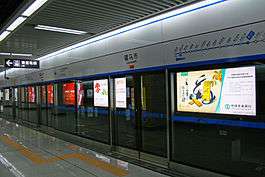
The Chengdu Metro officially opened on 1 October 2010.[68] Line 1 runs from Shengxian Lake to Guangdu (south-north). Line 2 opened on September 2012. Line 3 opened on July 2016. Line 4 opened on December 2015. Line 3 (Phase 2 and Phase 3), Line 4 (Phase 2), Line 5 (Phase 1, Phase 2), Line 7, Line 10 (Phase 1, Phase 2), Line 18 (Phase 1) are currently under construction. More lines are planned to start construction before 2016. Future plans call for more than twenty lines.[69]
Bus
Bus transit is the most important mode of public transport in Chengdu. There are more than 400 bus lines in Chengdu with nearly 12,000 buses in total. In addition, Chengdu BRT offers services on the Second Ring Road Elevated Road.
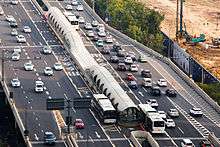
In Chengdu, you can buy a bus card which allows you to change the bus free in three hours after you take the bus.
River transport
Historically, the Jin River was used for boat traffic in and out of Chengdu. However, due to the size of the river itself and the reduced water depth over time, the Brocade River is no longer capable of carrying any type of water traffic. Therefore, Chengdu has no direct access to the Yangtze River or any other larger river. However, to ensure that Chengdu's goods have access to the river efficiently, the port cities of Yibin and Luzhou—both of which are reachable from Chengdu within hours by expressways—on the Yangtze have commenced large-scale port infrastructure development. As materials and equipment for the rebuilding of northern Sichuan are sent in from the East Coast to Sichuan, these ports will see significant increases in throughput.
Education
Chengdu is home to the greatest number of universities and research institutes in Southwestern China. It has 49 colleges and universities, including University of Electronic Science and Technology of China, Sichuan University, and Southwestern University of Finance and Economics. In 2010, over 140,000 students graduated from the colleges and universities, more than half of them majored in IT, finance, economics, business management, or foreign languages studies.
Colleges and universities
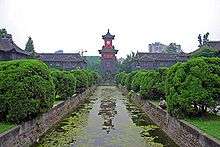
Chengdu is the center of higher education and scientific research in Southwest China.
- Sichuan University (SCU) (Founded in 1896), including the West China Medical Center of Sichuan University
- Southwest Jiaotong University (Founded in 1896)
- Southwestern University of Finance and Economics (Founded in 1925)
- University of Electronic Science and Technology of China (Founded in 1956)
- Sichuan Agricultural University (Founded in 1906) [70]
- Sichuan Normal University (Founded in 1946)
- Southwest University for Nationalities (Founded in 1951)
- Chengdu University of Technology (Founded in 1956)
- Southwest Petroleum University (Founded in 1958)
- Chengdu University of Traditional Chinese Medicine (CDUTCM) (Founded in 1956)[71]
- Sichuan Conservatory of Music (Founded in 1939)
- Chengdu University of Information Technology (CUIT) (Founded in 1951)
- Chengdu Kinesiology University (Founded in 1942)
- Xihua University (Founded in 1960)
- Chengdu University (Founded in 1978)
- Chengdu Medical College (Founded in 1947)
Note: Institutions without full-time bachelor programs are not listed.
International schools
- Oxford International College of Chengdu
- Chengdu Meishi International School
- Chengdu International School
- The Léman International School – Chengdu
- Quality Schools International: QSI International School of Chengdu
- Eton House
Major secondary schools
- Chengdu No.7 High School (Founded in 1902)
- Chengdu Shishi High School (Founded in 143 BC)
- Chengdu Shude High School (Founded in 1929)
- The Affiliated High School of Sichuan University
- The Affiliated High School of Sichuan Normal University
- Chengdu Experimental Foreign Languages School
- Chengdu Foreign Languages School
- Chengdu Jiaxiang Foreign Language School
Consulates
The United States Consulate General at Chengdu opened on 16 October 1985. It was the first foreign consulate in west-central China since 1949. Currently fourteen countries have consulates in Chengdu. The United Kingdom also has a visa application center in Chengdu.
| Consulate | year | Consular District |
|---|---|---|
| 1986 | Sichuan/Chongqing/Yunnan/Guizhou/Tibet AR | |
| 2003 | Sichuan/Chongqing/Yunnan/Guizhou | |
| 2004 | Sichuan/Chongqing/Yunnan/Guizhou | |
| 2004 | Sichuan/Chongqing | |
| 2005 | Sichuan/Chongqing/Yunnan/Guizhou | |
| 2006 | Sichuan/Chongqing/Shaanxi | |
| 2007 | Sichuan/Chongqing/Yunnan/Guizhou | |
| 2009 | Sichuan/Chongqing/Yunnan/Guizhou/Shaanxi | |
| 2013 | Sichuan/Chongqing/Yunnan/Guizhou | |
| 2014 | Sichuan/Chongqing/Yunnan/Guizhou | |
| 2014 | Sichuan/Chongqing/Yunnan/Guizhou | |
| 2015 | Sichuan/Chongqing/Yunnan/Guizhou | |
| 2015 | Sichuan/Chongqing/Yunnan/Guizhou | |
| 2015 | Sichuan/Chongqing/Yunnan/Guizhou |
Sports
Tennis
Chengdu is the hometown of Grand Slam champions Zheng Jie and Yan Zi, who won the women's double championships at both the Australian Open and Wimbledon in 2006. The recent tennis boom in China, has led to increased interest in tennis in Chengdu. Over 700 standard tennis courts have been built in the city in the past 10 years, and the registered membership for the Chengdu Tennis Association have grown to over 10,000 from the original 2,000 in the 1980s.[72]
Chengdu is now part of an elite group of cities to host an ATP (Association of Tennis Professionals) Champions Tour tournament, along with London, Zürich, São Paulo and Delray Beach. Chengdu Open, an ATP Championships Tour starting in 2009, have successfully invited star players including Pete Sampras, Marat Safin, Carlos Moya, Tomas Enqvist, and Mark Philippoussis.[73]
Football/Chengdu Blades F.C. (association football)
Football is a popular sport in Chengdu. Currently, Chengdu Blades Football Club, Chengdu's football team, plays in the 42,000-seat Chengdu Sports Stadium in the Chinese League One. The club was founded on 26 February 1996 and was formerly known as Chengdu Wuniu (Five Bulls) named after their first sponsor, the Wuniu (Five Bulls) Cigarette Company. The English professional football club, Sheffield United F.C., took over the club on 11 December 2005.[74] The club was later promoted into the China Super League until they were embroiled in a match-fixing scandal in 2009. Punished with relegation the owners eventually sold their majority on 9 December 2010 to Hung Fu Enterprise Co., Ltd and Scarborough Development (China) Co., Ltd.[75][76] On 23 May 2013 the Tiancheng Investment Group announced the acquisition of the club.[77]
Chengdu Longquanyi Football Stadium was one of the four venues which hosted the 2004 AFC Asian Cup. Chengdu, along with Shanghai, Hangzhou, Tianjin and Wuhan, hosted the 2007 FIFA Women's World Cup.
Major sports venues
Chengdu Sports Stadium
Chengdu Sports Stadium is located in downtown Chengdu, covering 140 acres (57 ha) and has 42,000 seats. As one of the landmarks of Chengdu, it's the first large multi-purpose venue in Chengdu that can accommodate sports competitions, trainings, social activities, and performances. It is the home stadium of the Chengdu Blades, Chengdu's football team. The stadium hosted 2007 FIFA Women's World Cup.
Sichuan International Tennis Center
Located 16 km (10 mi) away from Chengdu's Shuangliu International Airport, Sichuan International Tennis Center covers an area of 250,000 square metres (2,700,000 square feet). It is the largest tennis center in southwest China and the fourth tennis center in China meeting ATP competition standards, after Beijing, Shanghai and Nanjing. This center is equipped with 36 standard tennis courts and 11,000 seats. Since 2009, the Chengdu Open, an ATP Championship Tour tournament, is held here annually.
Sister or twin cities
|
|
See also
- Baiguolin
- List of cities in China by population
- List of current and former capitals of subnational entities of China
- List of twin towns and sister cities in China
Notes
- ↑ Chinese: 以周太王从梁王止岐山,一年而所居成聚,二年成邑,三年成都,因名之成都。
- ↑ Chinese: t 揚一益二, s 扬一益二, "Yang[zhou] 1[st], Yi[zhou] 2[nd]".
- ↑ "Let us now speak of a great Bridge which crosses this River within the city. This bridge is of stone; it is seven paces in width and half a mile in length (the river being that much in width as I told you); and all along its length on either side there are columns of marble to bear the roof, for the bridge is roofed over from end to end with timber, and that all richly painted. And on this bridge there were houses in which a great deal of trade and industry is carried on. But these houses were all of wood merely, and they are put up in the morning and taken down in the evening. Also there stands upon the bridge the Great Kaan's _Comercque_, that is to say, his custom-house, where his toll and tax were levied."[8]
References
Citations
- 1 2 "龟城刘备审阿斗_中华文本库". Chinadmd.com (in Chinese). 2015-06-29. Retrieved 2015-12-31.
- 1 2 "3-2各市(州)年末常住人口、出生率、死亡率、自然增长率、城镇化率和人口密度(2014年)-tjsql.com". www.tjsql.com. Retrieved 2016-03-06.
- ↑ "最新中国城市人口数量排名(根据2010年第六次人口普查)". www.elivecity.cn. 2012. Retrieved 2014-05-28.
- ↑ "Chengdu, the City Whose Name hasn't changed for 2300 years". cd.wenming.cn. 6 January 2011. Retrieved 6 January 2011.
- 1 2 "Chang Hsien-chung". Eminent Chinese of the Ch'ing Period. Qing Research Portal, Dartmouth College.
- ↑ Wilkinson, Endymion (2000), Chinese History: A Manual, Harvard University Asia Center, p. 849
- 1 2 Quian, Jack, Chengdu: A City of Paradise, 2006. Cf. p.109
- 1 2 Yule, Henry; et al. (eds.), The Travels of Marco Polo, Vol. II, Ch. XLIV
- 1 2 Encyclopaedia Britannica, 9th ed. (1878), Vol. V, "China".
- ↑ "成都味道 PDF – 综合课件 – 道客巴巴". Doc88.com. 2013-06-02. Retrieved 2015-12-31.
- ↑ "Chengdu Unveils its New City Logo". news.ifeng.com. 2011-12-30. Retrieved 2012-02-10.
- ↑ Sage, Steven F. (1992). Ancient Sichuan and the unification of China. Albany: State University of New York Press. p. 16. ISBN 0791410374.
- ↑ Liang Deng; et al. (2001). History of China. 五洲传播出版社. p. 171. ISBN 7-5085-1098-4.
- ↑ Charles Horner. Rising China and Its Postmodern Fate: Memories of Empire in a New Global Context. University of Georgia Press. ISBN 978-0820338781.
- ↑ Mayhew, Bradley; Miller, Korina; English, Alex, South-West China, Lonely Planet Publications, 1998 (2nd edition 2002). Cf. p.19 on the Mongul Reign: Yuan Dynasty.
- ↑ Yingcong Dai (2009). The Sichuan Frontier and Tibet: Imperial Strategy in the Early Qing. University of Washington Press. pp. 22–27. ISBN 978-0-295-98952-5.
- ↑ Cambridge History Vol 11, Part 2:522
- ↑ Cambridge History Vol 11, Part 2:524
- ↑ "Chinese continue to seek justice for Japanese bombings – China". Chinadaily.com.cn. Retrieved 2015-12-31.
- ↑ "Håkans Aviation page – Sino-Japanese Air War 1939". Surfcity.kund.dalnet.se. Retrieved 2015-12-31.
- ↑ Jun 5 1941 Thousands die in Chungking raid (1941-06-05). "5th June 1941: Thousands die in Chungking raid". Ww2today.com. Retrieved 2015-12-31.
- ↑ Archived 12 August 2014 at the Wayback Machine.
- ↑ "Major 'Buffalo' Wong Sun-Shui". Century-of-flight.net. Retrieved 2015-12-31.
- ↑ "Chinese biplane fighter aces – 'Buffalo' Wong Sun-Shui". Surfcity.kund.dalnet.se. Retrieved 2015-12-31.
- ↑ Haulman References Chapter The Superfortress Takes to the Skies p. 4
- ↑ Crosby, Jim. Location of China Bomber bases, 1944–45 Archived 18 February 2012 at the Wayback Machine., website created by David Wilhelm in memory of Sgt. Daniel L. Wilhelm, USAAF Archived 13 December 2013 at the Wayback Machine., Retrieved 12 May 2014
- ↑ 重返新津机场美国老兵泪光闪烁 (Chinese)
- ↑ United States Strategic bombing survey summary report (Pacific War), Washington D.C. 1 July 1946. Page 16.
- ↑ Cook, Chris Cook. Stevenson, John. [2005] (2005). The Routledge Companion to World History Since 1914. Routledge. ISBN 0-415-34584-7. p 376.
- ↑ Davies, Alex (2 November 2012). "China Is Building A Huge Eco-City Where No One Will Need To Drive". Business Insider. Retrieved 27 January 2013.
- ↑ 为什么重庆、武汉、南京有"三大火炉"之称? (in Chinese). Guangzhou Popular Science News Net (广州科普资讯网). 2007-09-12. Retrieved 2010-11-29.
- ↑ "Extreme Temperatures Around the World". Retrieved 2015-11-04.
- ↑ 中国地面国际交换站气候标准值月值数据集(1971-2000年) (in Chinese). China Meteorological Administration. Archived from the original on 18 March 2013. Retrieved 2010-05-04.
- ↑ "中央机构编制委员会印发《关于副省级市若干问题的意见》的通知. 中编发[1995]5号". 豆丁网. 19 February 1995. Archived from the original on 29 May 2014. Retrieved 2014-05-28.
- ↑ "Illuminating China's Provinces, Municipalities and Autonomous Regions-Sichuan". PRC Central Government Official Website. 2001. Retrieved 11 May 2014.
- ↑ "中华人民共和国县以上行政区划代码". 中华人民共和国民政部.
- ↑ shi, Guo wu yuan ren kou pu cha ban gong; council, Guo jia tong ji ju ren kou he jiu ye tong ji si bian = Tabulation on the 2010 population census of the people's republic of China by township / compiled by Population census office under the state; population, Department of; statistics, employment statistics national bureau of (2012). Zhongguo 2010 nian ren kou pu cha fen xiang, zhen, jie dao zi liao (Di 1 ban. ed.). Beijing Shi: Zhongguo tong ji chu ban she. ISBN 978-7-5037-6660-2.
- ↑ 中华人民共和国民政部 (August 2014). 《中国民政统计年鉴2014》. 中国统计出版社. ISBN 978-7-5037-7130-9.
- ↑ Roberto A. Ferdman (3 July 2013). "The world's new largest building is four times the size of Vatican City". Quartz. Quartz. Retrieved 4 July 2013.
- ↑ "China: Administrative Division of Sìchuān / 四川省 (Prefectures, Cities, Districts and Counties) – Population Statistics in Maps and Charts". Citypopulation.de. Retrieved 2015-12-31.
- ↑ Jing, Fu (2006-01-03). "Beijing drops out of top 10 'best city' list". China Daily.
- ↑ "成都石室中学". Cdshishi.net. Retrieved 2013-12-10.
- ↑ Lee, Don (2006-02-08). "People's Party Animals". Los Angeles Times.
- ↑ "Gastronomy – United Nations". UNESCO. 2012-07-30.
- ↑ "阳光下最热闹的地方 外地人眼中的成都茶文化". Sina Sichuan. 2011-04-13. Retrieved 2012-02-09.
- ↑ "Playing Mahjong games, the popular way of relaxation in Chengdu". What'sonchengdu.com. 2011-01-28. Retrieved 2012-02-09.
- ↑ Archived 14 December 2013 at the Wayback Machine.
- ↑ Archived 24 September 2012 at the Wayback Machine.
- ↑ Archived 3 June 2013 at the Wayback Machine.
- 1 2 3 "Chengdu Leading the West (in Chinese)". 2009-10-21.
- ↑ "Chengdu Eyes a ¥90b Biopharma Industry (in Chinese)". Thechinaperspective.com. 2009-10-20. Retrieved 2013-12-10.
- ↑ "Branches of Fortune 500 Businesses in Chengdu". Investchengdu.gov.cn. 2007-10-29. Retrieved 2013-12-10.
- ↑ "Dell To Build Flagship Manufacturing and Customer Support Center In Chengdu To Support Western China Growth; Expands Xiamen Operations". Dell. 16 September 2010. Retrieved 24 September 2010.
- ↑ "IBM Expands Global Delivery Capabilities to Inland China". IBM Press Room. 2006-11-27. Retrieved 2009-08-28.
- ↑ "IBM 成都分公司" (in Chinese). IBM Press Room.
- ↑ "IBM to Further Investment in Chengdu". People's Government of Sichuan Province.
- ↑ "WCG 2009 in Chengdu, China". Sk-gaming.com. Retrieved 2013-12-10.
- ↑ "Welcome to Invest Chengdu!". Chengduinvest.gov.cn. Retrieved 2013-12-10.
- ↑ "Real estate changes Chengdu". Chengdu Business Newspaper. 2008-12-23.
- ↑ Zhang Zhiying (2008). "30-year history of Chengdu real estate market". Shanghai Real Estate vol.7. p. 14.
- ↑ zh:中华人民共和国机场运营统计列表
- ↑ "Agreement to build an airport hub in Chengdu". People's Net. 2009-05-26.
- ↑ "Chengdu airport". Sina. 2009-05-26.
- ↑ "Poland-China cargo train a success". wbj.pl. 2013-06-03. Retrieved 2013-12-10.
- ↑ "Chengdu city info southwest china". Retrieved 2010-03-05.
- ↑ (Chinese) "四川建首条城际快客 连通成都和都江堰" 新民晚报 2014-05-12
- ↑ "Chengyu Passenger Line achieves breakthrough – video – CQNEWS_English". English.cqnews.net. 2013-12-17. Retrieved 2015-12-31.
- ↑ "Chengdu Metro Company website". Cdmetro.cn. Retrieved 2013-12-10.
- ↑ "我国中西部地区第一条地铁开通_新闻中心_新浪网". News.sina.com.cn. 2010-09-28. Retrieved 2011-03-15.
- ↑ "Sichuan Agricultural University". Ghc.sicau.edu.cn. 2010-03-10. Retrieved 2011-03-15.
- ↑ "Chengdu University of Traditional chinese Medicine website". Cdutcm.org. 2009-11-09. Retrieved 2011-03-15.
- ↑ "成都网球协会". Cd-wx.com. Retrieved 2013-12-10.
- ↑ 最適な水~水素水を作る整水器、軟水を作る業務用軟水器~ | 軟水を作る業務用軟水器、水素水を作る整水器について (in Japanese). Chengduchampions.com. Retrieved 2013-12-10.
- ↑ "Hongkong 2008/09". Rsssf.com. 2009-09-24. Retrieved 2015-12-31.
- ↑ Archived 3 December 2013 at the Wayback Machine.
- ↑ "英投资方决定成都谢菲联不出售 尽快解决欠薪稳军心_国内足球-中超_新浪竞技风暴_新浪网". Sports.sina.com.cn. Retrieved 2015-12-31.
- ↑ "成足更名天诚谢菲联 短期内回中超3年内进亚冠-搜狐体育". Sports.sohu.com. 2010-09-09. Retrieved 2015-12-31.
Bibliography
- Mayhew, Bradley; Miller, Korina; English, Alex, South-West China, Lonely Planet Publications, 1998 (2nd edition 2002). Cf. p. 444 for its article on Chengdu.
- Quian, Jack, Chengdu: A City of Paradise, 2006
Further reading
- Ling Zhu, "Chengdu, the city of spice and tea", China Daily, Government of China, Friday, 22 December 2006
- Anna Zhang, "City Profile: Chengdu – Land of Abundance", Shanghai Business Review, July 2012.
External links
| Wikivoyage has a travel guide for Chengdu. |
| Wikimedia Commons has media related to: |
- Official Website of the Chengdu Government
- Official Website of the Chengdu Government (simplified Chinese)
 Geographic data related to Chengdu at OpenStreetMap
Geographic data related to Chengdu at OpenStreetMap
| Preceded by Chongqing |
Capital of the Republic of China 30 Nov 1949 – 27 Dec 1949 |
Succeeded by Taipei |
| Largest cities or towns in China Sixth National Population Census of the People's Republic of China (2010) | |||||||||
|---|---|---|---|---|---|---|---|---|---|
| Rank | Name | Province | Pop. | Rank | Name | Province | Pop. | ||
 Shanghai .jpg) Beijing |
1 | Shanghai | Shanghai | 20,217,700 | 11 | Foshan | Guangdong | 6,771,900 | 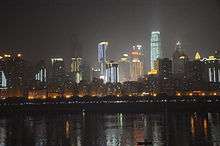 Chongqing 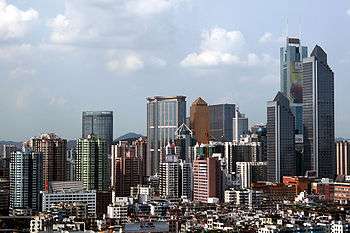 Guangzhou |
| 2 | Beijing | Beijing | 16,858,700 | 12 | Nanjing | Jiangsu | 6,238,200 | ||
| 3 | Chongqing | Chongqing | 12,389,500 | 13 | Shenyang | Liaoning | 5,890,700 | ||
| 4 | Guangzhou | Guangdong | 10,641,400 | 14 | Hangzhou | Zhejiang | 5,578,300 | ||
| 5 | Shenzhen | Guangdong | 10,358,400 | 15 | Xi'an | Shaanxi | 5,399,300 | ||
| 6 | Tianjin | Tianjin | 10,007,700 | 16 | Harbin | Heilongjiang | 5,178,000 | ||
| 7 | Wuhan | Hubei | 7,541,500 | 17 | Dalian | Liaoning | 4,222,400 | ||
| 8 | Dongguan | Guangdong | 7,271,300 | 18 | Suzhou | Jiangsu | 4,083,900 | ||
| 9 | Chengdu | Sichuan | 7,112,000 | 19 | Qingdao | Shandong | 3,990,900 | ||
| 10 | Hong Kong | Hong Kong | 7,055,071 | 20 | Zhengzhou | Henan | 3,677,000 | ||
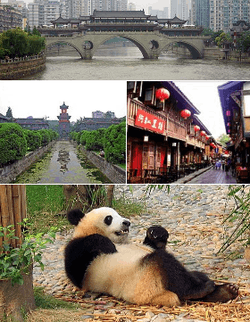

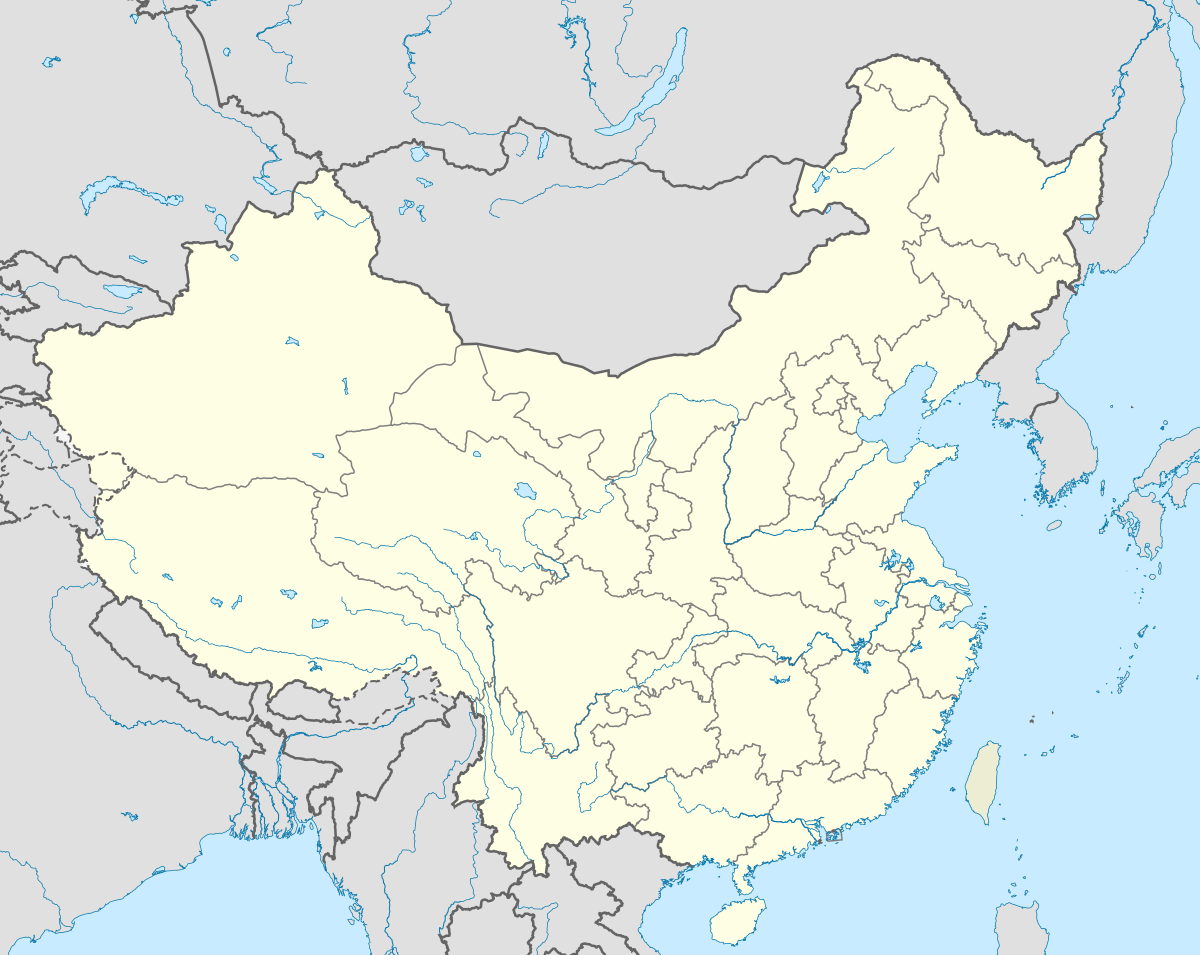
.svg.png)

